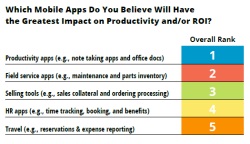Mobile Apps Getting More Strategic
Mobile app adoption in the enterprise is growing strongly, as recent surveys show. For instance, Good Technology found mobile app activation in the enterprise grew 160 percent from Q1 2014 to Q1 2015.
A new report from Apperian, a provider of mobile application management software, yielded similar results, finding that 52 percent of surveyed companies are rolling out mobile apps to more than 2,000 users, while 33 percent are rolling apps out to 1,000 users or fewer.
Enterprise Mobility 3.0
Some statistics from the report also suggest that enterprises are “moving from mobile 2.0, which was focused on email, calendar and contacts, and progressing into mobile 3.0 which is focused on using mobile apps and data to create a competitive advantage and real business value,” said Alan Murray, SVP of Products at Apperian.
 Nearly half of all companies are creating apps to drive core business processes and a quarter of them deliver apps to what Murray calls the “extended enterprise,” dealers, partners, suppliers and contracted workers. “As they equip key workers with mobile apps and data, companies are changing the way people and industries work,” he said.
Nearly half of all companies are creating apps to drive core business processes and a quarter of them deliver apps to what Murray calls the “extended enterprise,” dealers, partners, suppliers and contracted workers. “As they equip key workers with mobile apps and data, companies are changing the way people and industries work,” he said.
Respondents expect these practices to result in top-line benefits, with 39 percent of them saying they expect to gain new revenue or service delivery opportunities, up from 30 percent the prior year.
Improved business processes, cited by 64 percent of participants, were seen as the top benefit of mobile apps. This was followed by increased user satisfaction and competitive advantage, both of which were mentioned by 60 percent of respondents.
Custom Mobile Apps
Like other surveys, the Apperian report showed a preference for custom mobile apps created in-house. Sixty percent of respondents had created custom mobile apps, while 35 percent had contracted with a third party to create customs apps. In addition, 63 percent said they purchase mobile apps from vendors and 52 percent download enterprise mobile apps from public app stores like Google Play and Apple's App Store.
Apperian found that companies most satisfied with their mobile apps were more likely than others to have developed their own apps internally. This is because investing in internal app development “helps to create a culture focused on mobile excellence,” said Alan Murray, SVP of Products at Apperian.
“With custom-built apps, organizations tend to invest more in the app’s success and engage in strategies to increase user adoption, like internal marketing and private app stores,” he said. “Companies that develop apps internally, using their intimate knowledge of customers and business processes, are more likely to gain a substantial competitive advantage with their mobility programs.”
Mobile App ROI
Respondents tapped productivity apps such as note taking and office doc apps as yielding the greatest ROI, followed by mobile field service apps, including maintenance and parts inventory apps. Yet 32 percent of companies mentioned inability to determine ROI as a barrier to enterprise mobility.
Difficulty in determining ROI is due, in part, to companies' tendency to focus on the cost side of the mobile ROI equation, rather benefits such as increased worker productivity, Murray said.
Legacy tools used by many companies don’t provide the type of analytics and management capabilities required to determine the return on mobile app investments, he added.
“Companies should invest in app analytics to not only better understand the return on their investments, but to also help improve the quality of their apps, identify ways to increase adoption and understand where to invest in the future,” he said.
Just more than half of respondents track which mobile apps are being used, the survey found. Forty-eight percent of them can see who is using their mobile apps, and 42 percent can see how frequently apps are used.
Mobile App Metrics
Apperian believes every organization should monitor three key metrics, Murray advised. They are:
- App adoption – How many people download the mobile app out of the targeted population?
- App usage and retention – How often do employees use a mobile app? How long do employees use the app? How do different populations use the app differently?
- User experience – How do users interact with different screens within the mobile app? Which areas of the app do users interact with most?
- App quality – How often does the app crash? How long does the app take to load?
Ann All is the editor of Enterprise Apps Today and eSecurity Planet. She has covered business and technology for more than a decade, writing about everything from business intelligence to virtualization.

Public relations, digital marketing, journalism, copywriting. I have done it all so I am able to communicate any information in a professional manner. Recent work includes creating compelling digital content, and applying SEO strategies to increase website performance. I am a skilled copy editor who can manage budgets and people.



